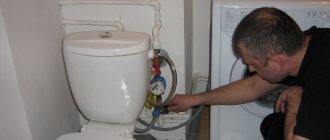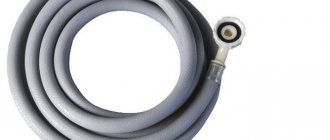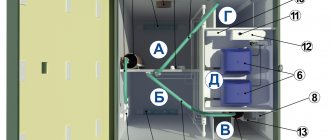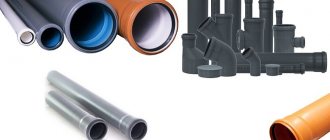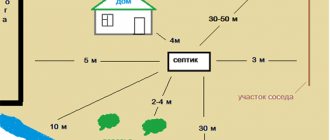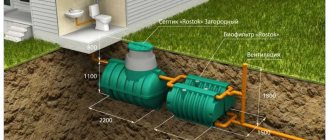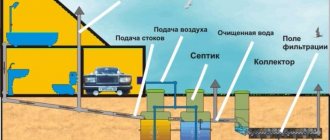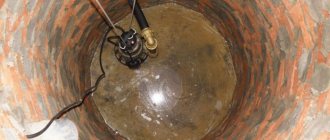Household appliances of this type have long become an indispensable attribute for most households. Purchasing and connecting washing machines to sewerage and water supply has long become commonplace and most of us know how it’s done.
However, in this article we will dwell on the issue in detail and analyze all the nuances of connecting to water supply and sewerage, what methods exist, what tools and materials we will need, and how to avoid common mistakes.
But first, let's briefly learn how to connect a washing machine: the hose for connecting cold water is screwed at one end to the water pipe, and the other to the filler fitting of the machine. The end of the drain hose at a certain height is connected to the sewer system. Below, we will look at all the processes in more detail.
Materials and tools for connecting to water supply and sewerage
The need for certain materials when installing and connecting washing machines to sewerage and water supply is determined, first of all, by the location of the unit and the accessibility of the designated objects. In some cases, it is necessary to incur significantly higher costs in order to subsequently use household appliances conveniently for many years.
If you plan to lay additional branches from the water supply in the groove, you will need a fairly powerful angle grinder with a saw blade for concrete. You can use a hammer and a chisel to break out the concrete.
A pipe without joints is laid in the groove to ensure its long-term operation without leakage. Otherwise, if a leak occurs, restoring the functionality of the pipe will involve a large amount of troubleshooting work.
To connect to the water supply network, a tee with a shut-off valve is usually used, and to install it in place, a set of wrenches or a universal adjustable wrench is used. All threaded connections are sealed with tow or FUM tape.
Installing an external pipe involves attaching the pipe to the wall; for this you will need an electric drill and concrete drills. Plastic dowels are installed in the drilled holes, fastening is carried out with screws of the appropriate size.
When installing washing machines, the main requirement is that the top cover is horizontal in relation to the floor. For precise installation of the washing machine, a building level is used; adjustment is made using screw support legs.
To arrange a drain for washing machines into the sewer, you will need a drain adapter with an outlet at an angle of 45 degrees.
To connect washing machines to electricity, you will need a three-core cable with a cross-section of 2.5 square meters in double insulation and a 16-amp diffusion machine with a leakage current of no more than 30 milliamps.
In addition, it is possible to use control equipment - a voltmeter. Let’s take a closer look at how to properly connect the washing machine to the mains below.
How should the drain flexible pipe be positioned correctly?
The height at which it is decided to lay the drain hose is very important, and it, in turn, is determined by the power of the pump that pumps out dirty water. The minimum distance from the floor at which the corrugation can be placed is 550 mm, taking into account that it is connected to a siphon or “tee”. If water will be drained directly into plumbing fixtures, the discharge height should not exceed 1,000 mm. The length of the corrugated pipe recommended by the manufacturer from the machine to the entry into the sewer is about 1,500 mm.
Attention! Incorrect connection of the washing machine will void the right to warranty repair of household appliances.
Preparing washing household appliances for installation
First of all, when the unit is delivered to the installation site, it needs to be unpacked. Usually the machine is packed in a cardboard box and secured with plastic tape. It needs to be cut and removed.
After this, the cardboard box is carefully removed and the foam pads are removed from the top and sides. Next, you need to lift the car and pull out the lower foam platform.
In this case, it is worth paying attention to its design - if there is no special boss in the middle on which the device drum rests in the transport position, then in this design it is manufactured and installed separately. You need to tilt it and remove this insert.
Please note that the cardboard packaging and foam pads must be retained for the duration of the warranty. If a situation arises in which you need to replace the machine due to its defect, this operation will not take place without packaging. These are the terms of the guarantee.
Inside the cardboard package there is an envelope or folder with technical documentation. It contains:
- A passport for the purchased washing machine indicating the personal unit number and other credentials. All entries in it must be certified by the store’s seal.
- A warranty card, which is certified by the store’s seal indicating the date of sale, since the countdown of the warranty period begins with it.
- Operating instructions, starting from the moment of unpacking, and instructions on the installation procedure.
You should strictly follow all the manufacturer's requirements, since failure to comply with any of them will result in a waiver of warranty obligations.
Connecting a washing machine
The packaging also contains the components of the purchased washing machine. Typically they include:
- Flexible filling hose equipped with plastic union nuts for connection to the machine and water supply;
- drain hose for removing used water after washing and spinning clothes;
- reduction – an intermediate part for connecting the drain hose to the sewer pipe;
- bracket for fixing the drain hose on the wall;
- wrench for removing transportation screws and adjusting the position of household appliances in space before turning them on;
- plugs installed on the holes for transportation screws after they are removed.
These are the main items of the sales kit, which may differ from model to model.
If your washing machine breaks down, you can connect the motor from it to a 220 V network with your own hands.
Removing shipping screws
This is a mandatory operation before connecting washing machines to water supply and sewerage.
Their purpose is to secure the drum during transportation to prevent damage. As noted above, a tool for removing bolts is included in the sales package.
Under no circumstances should the removed screws be thrown away; they will be useful if you need to transport the washing machine to a warranty workshop. The holes where the transport screws were must be closed with the covers included in the sales kit.
Placement options for washing household appliances
Household appliances of this kind are not purchased spontaneously; the purchase is preceded by careful analysis and preparation. First of all, this applies to the installation location.
The need to drain used water determines the location of washing machines as close as possible to the distribution of the sewer system.
Such points are located either in the bathroom or in the kitchen. There is also a water supply network there.
As for connecting to electricity, washing machines may require a separate power supply line from the input panel to the location where the outlet is installed.
Unpacking the machine
Manufacturers take great care in transporting their goods. The washing machine is carefully packaged. They do this in order to prevent damage during transportation.
The machine must be freed from its original packaging and the transport bolts that secure the device tank must be removed. They are easily unscrewed, and plugs are attached instead.
Attention! Do not operate the washing machine with transport bolts, as this may cause damage. The warranty does not cover such a problem.
Connecting washing machines to the water supply - several connection methods
Watch the video - the first method of establishing a connection to the water supply
How to install a washing machine, connecting the washing machine to the water supply. Video tutorial Plumber
The sales package for such a unit always includes a hose for connecting cold water. Its length is 1.2-1.5 meters and at the ends the hose is equipped with two union nuts made of plastic.
One of the ends is installed on the hose at a right angle. It must be installed on the inlet of the unit. The installation angle prevents the hose from kinking or pinching. Connection is made in the following order:
- Turn off the water supply to the water supply by turning off the tap on the riser.
- Unscrew the flexible cold water line at the sink or sink.
- Install the tee onto the supply pipe in the water supply system so that the side outlet is located conveniently for connecting the washing machine hose.
- Screw the filling hose to the tee. When tightening the plastic nut, do not use a tool, and only tighten the nut until it stops by hand. Tool installation often results in breakage of the flimsy plastic nut.
- Install the flexible mixer hose.
A test supply of water to the system with the washing machine should be carried out with the tap on the crosspiece closed, and only after making sure that there are no leaks can it be opened to check the reliability of the hose connection.
This connection option is used when the installation location of the unit coincides with the location of the sink or sink.
Otherwise, you need to bring the water closer to it. To do this, a tee is inserted into the nearest water pipe.
An additional pipe of the water supply system is extended to the installation site of the washing machine, where it is connected in the manner described above.
Often, filling the household with household appliances occurs gradually; eventually, under the sink or sink, the entire space is filled with tees and a tangle of various hoses.
How to connect a washing machine (review video)
Providing for this possibility, a manifold with several outlets is installed on the embedded pipe. An output that is not currently in use can be closed with a plug and used at the right time.
Design
The ball valve has a simple design, a high degree of water resistance, small size and easy to use, the main structural elements of the standard product are:
- Frame. The typical collapsible design is made of nickel-plated or chrome-plated brass; the inlet and outlet pipes have external threads for connection to the pipeline and plumbing fixtures, electrical equipment.
- Ball. Made of ground and polished brass, coated with chrome, inside its body there is a rectangular recess on top into which the stem is inserted.
- Stock. It is a brass rod with sealing rubber rings installed on the body; a tap is attached to one of its ends. There is a hole at the top for screwing in a fixing screw, or the pulley has a thread for attaching the handle to the nut. The opposite side of the stem has a rectangular cross-section and is designed for insertion into the ball valve body.
- Seat and seal rings. Seat rings located on both sides of the ball at the inlet and outlet of the passage channel provide a tight seal, preventing water from entering the outlet pipe when closed. A rubber ring placed on one of the parts of the body prevents it from leaking when connected to another part.
- Pen. The rotary handle is made in the shape of a butterfly or an elongated lever, attached to the rod with a screw or a self-locking nickel-plated steel union nut. It is made of aluminum, nickel-plated steel, coated with polymers in a liquid plasticizer (plastisol).
Characteristics and materials of a typical valve
Connecting washing machines to the sewer - consider 2 methods
Watch the video - the first method of installing a drain into the sewer
Washing machine. Drain through non-return valve. Eliminating the siphon effect
Draining used water into the sewer system is a mandatory process in the operation of units of this kind, because the purification of contaminated wastewater is becoming increasingly important.
If we simply talk about organizing the drainage of water from washing machines into the sewer system, we can do without directly connecting these two systems.
It is enough to use a U-shaped bracket from the unit sales kit, which fixes the drain pipe on the edge of the bathtub. At the same time, the issue of the height of the drain into the sewer is resolved, due to which a water plug is formed, preventing the reverse flow of water.
Many modern units include the installation of a check valve that prevents this process.
Considering the specific location of the sewer system in a house or apartment, there are no problems with connection, but it has its own specifics.
Connecting to the sewer directly is used quite often, being the simplest to implement. But this method has its drawbacks.
To implement this, it is necessary to install a spacer to the sewer pipe in the form of a tee, and the outlet should be at an angle of 45 degrees.
The drainage hose is connected to a sewer pipe with a diameter of 50 millimeters, while its size is 22 mm. Therefore, the connection is made using a special spacer called a “reduction”.
The drainage hose of washing machines is standardized on all models and has a diameter of 22 millimeters. There are no special adapters for draining this size; this simple rubber part is used on the transition.
When the machine is located in close proximity to the outlet of a sewer pipe, it is naturally connected to it using a tee.
Do-it-yourself connections of the washing machine to water and sewerage
But if the unit is located at the opposite end of the room, the most reasonable solution would be to lay an additional PVC pipe with a diameter of 32 millimeters and then switch to size 50.
In this case, it is necessary to fulfill the requirements for a slope of this pipe of 2-3 millimeters per meter of length. A reduction with these dimensions is produced and can be purchased on the market.
In some cases, if the machine is automatic, there is no need to use an intermediate pipe, since the used water is pumped out by a pump.
In this case, the connection is made using a rubber reduction. It is a rubber bushing. The outer surface has ribs like a cuff to seal the connection. The inner hole is arranged in the same way with a diameter of the appropriate size.
In the technical documentation, if there is no check valve in the machine model being installed, the height of the drain from the floor at which a water seal is formed must be indicated.
If this parameter is not maintained, very unpleasant odors will penetrate into the room through the drain hole.
The second way to connect washing machines to the drain is to connect through a siphon. Many of these products are available with a special outlet at the top.
When sold, it is equipped with a special plug that covers the pipe. Before connecting the drain hose of the machine, this part must be removed and removed - it has purely protective functions.
The drain hose of the washing machine is simply put on this pipe and, if necessary, additionally secured with a clamp.
This product can be equipped with several taps, which allows the connection of several units at the same time.
If there is such a possibility, connecting washing machines should be done in such a way that is quite reliable and solves all problems of tightness and safety.
The pressure switch is broken - water level sensor
The pressure switch is a very important element of an automatic washing machine. It detects the amount of water in the washing tub and commands the inlet valve to supply water. If an incorrect command is received from the sensor, the electronics considers that there is not enough water in the machine and gives the command to fill the washing tank.
The pressure switch may fail due to the following:
- the rubber membrane has lost its tightness. It should be taken into account that all rubber parts gradually lose their performance properties during operation and require replacement;
- The sensor contacts have oxidized. They should be cleaned or replaced;
- sensor fill tube is clogged. This tube becomes clogged due to scale, small debris present in the water. As a result, the sensor provides deliberately false information about the amount of water in the drum. In this case, it must be replaced. It should be noted that the pressure switch is not a very expensive part, so if problems arise with it, it is easier to put a new one in the car than to repair the old one.
Connecting washing machines to the electrical network
When making repairs in a bathroom or kitchen, you must provide wiring for connecting a washing machine or other similar equipment. It should be understood that combining water and electricity in one unit makes it a means of increased danger. Therefore, separate wires are pulled to connect them.
Connecting the washing machine drain to the sewer system, what problems and errors occur
Based on the maximum total power possible in such household appliances, you should usually focus on 2.3-3.0 kW.
What you need to connect
The list of materials for creating an autonomous network for connecting household appliances is not extensive and includes:
- Conductor products are selected from copper samples. At the same time, taking into account the place of application, they must be double insulated.
- An emergency shutdown control device that will save household appliances from failure due to voltage surges, and the building from a possible fire. The equipment will not be damaged if moisture gets into the electrical network.
How to connect a washing machine to a Miele three-phase network
To connect washing machines, a 16-amp device with a leakage current of no more than 30 milliamps is used.
- An automatic switch with the same parameters is installed in case of a short circuit and protects the network from damage.
- High security socket with moisture protection.
- Additional materials include common parts for electrical installation - clamps, terminals, junction boxes, cable ducts, etc.
Electrical installation
We draw your attention to the need to follow all the rules in order to ensure your own safety and the safety of your property and home:
- During installation, you must use only professionally designed connection diagrams.
- Do not twist aluminum and copper wires together.
- To carry out wiring, you need to use wires only of the appropriate cross-sectional power.
- Grounding cannot be done by connecting a wire to a water pipe or hot water supply.
- The sockets used must be made on a ceramic base in a waterproof casing.
- It is strictly not recommended to use an extension cord or adapter from a regular outlet to a Euro plug to connect washing machines.
- It is prohibited to connect the ground wire to the neutral wire.
- The connection wire must be laid as a separate line.
After completing the electrical installation, it is recommended to carefully check the entire circuit with a tester to eliminate the possibility of a short circuit.
Connecting the washing machine to water supply, sewerage and electricity.
Purpose
The idea that a tee tap for a washing machine is not so important appears in many people’s minds. Such users are most likely unaware of the concept of water hammer in water pipes, as a result of which both metal and metal-plastic pipes can separate at the seam. And if the inlet hose is connected directly to the water supply, there is a high risk that it will break due to such a water hammer, which will lead to water flows in the apartment.
Using a tee tap will save you from the need to redo repairs both in your apartment and in the neighbors below. And it is the tee that is especially convenient, as it allows you to connect several household appliances into the water supply at once, for example, a dishwasher and washing machine.
How to level a washing machine
This operation is final and is performed after it is connected to all communications. If this is not done, the machine will be overloaded during operation, and strong drum vibrations will occur, which will not extend its service life.
The top cover of the unit must be positioned horizontally. To do this you need to perform the following operations:
- Install the washing machine in its permanent location. The distance from the back panel to the wall should be no more than 5 centimeters, otherwise the hoses may be deformed or broken.
- Loosen the locknuts on the machine legs.
- Use a spirit level to determine the direction of rise or fall.
- Adjust the position of the unit by unscrewing or tightening the screws. The tolerance for non-parallelism of the cover in relation to the floor is no more than 2 degrees.
- Having achieved the correct position of the machine body, you need to tighten the locknuts to the body.
- It is important to prevent vibration of the unit, which can occur if there is a gap between the leg and the floor. To do this, you need to try to swing the body in different directions. If necessary, tighten the legs until the same tightening force is achieved.
Hose outlet to plumbing
Proper connection is a troublesome matter and requires serious plumbing work. Most often, owners of washing machines use a primitive drainage system, without connection to a sewer pipe. Each machine comes with a plastic attachment in the shape of a hook. It is put on the hose from the edge and thrown over the sink or bathtub. This type of water drainage has the following advantages:
- quick installation, no installation skills required;
- no need to mess with the pipeline;
- no special tools or knowledge required.
First start
To check the functionality of the installed washing machine, it is necessary to carry out a test wash. This is done in the following order:
- Connect the machine to the network.
- Select the desired washing mode and set it on the display.
- Enable work mode. When pouring water into the tank, monitor its filling time in comparison with the passport data. If the machine fills slowly, it is necessary to check the pressure in the water supply and, if necessary, take measures to increase it in accordance with the passport recommendations.
- Check the water heating time for the selected mode.
- When filling the tank with water, check for leaks; if there are any, eliminate the cause and repeat the tests.
The program and rules for conducting a trial run are described in detail in the relevant technical documentation. Recommendations for different models may differ, but these should be used as a guide.
